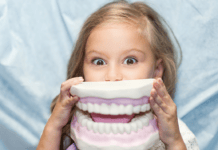Dazzlers, twinklers, and grills. Those names sound like confections invented by Willie Wonka! While they might prompt images of tasty treats, they are actually names of oral jewelry attached to the teeth by a process referred to as intentional dental modification (IDM).
Deliberate body modifications in the form of tattoos, scarring, and piercings have been used by humans as far back as the Ice Age. They have been used as part of religious rituals and traditions and to relay information about themselves and their society. Included in deliberate body modification is intentional dental modification, which is defined as the practice of purposefully changing the appearance of human teeth through extractions (ablation), stains, inlays, filing, or notching.1
Marco Polo noted an example of IDM in his travelogue from the 13th century, “Both men and women of this province (Kardandan) have the custom of covering their teeth with thin plates of gold, which are fitted with great nicety to the shape of the teeth and remain on them continually.”2
This practice of modifying teeth to express individuality and beauty continues to be practiced in various forms in virtually every corner of the planet even today.
Fashion Meets Dentistry
Television and social media have influenced the importance of fashion and beauty in daily life. In fact, social media influencers post billions of photos and videos each day.3 With all these images available at the touch of a button, it is no wonder that fashion plays a significant role in an increasingly important factor in one’s appearance.
Tooth jewelry is considered a cosmetic procedure and is often embraced by celebrities and musicians who may incorporate tooth jewelry into their smiles, making them a popular fashion trend amongst their fans and followers.4
Today, there is a growing desire for a perfect, pearly white smile. Dentistry has aided this quest by providing state-of-the-art dental treatments. As a result, the options for enhancing one’s smile with oral ornaments in the form of tooth jewelry have become popular. The array of options for tooth jewelry includes dazzlers, twinkles, tooth gems, grills, tooth rings, and tooth tattoos.
Dazzlers, Twinkles, and Tooth Gems
Dazzlers and twinkles are special glass or precious stones mounted on a thin multi-carat gold coating. Tooth gems are crystals mounted on thin aluminum foil. Generally, the maxillary anterior teeth are the most popular location for placement. They are adhered to the tooth with a flowable composite.5
The basic application steps include:5
- Clean the surface of the tooth
- Dry and isolate the area
- Etch with phosphoric acid, rinse and dry
- Apply a light-cured bonding agent and cure
- Apply a small amount of a flowable composite
- Place the jewel in the desired position and cure
Dazzlers, twinkles, and tooth gems may cause trauma to the lips and mucosa if normal function is hampered by the jewel. Precautions during placement and patient education can help reduce trauma to tissues.5
The jewelry’s attachment area is prone to plaque accumulation, resulting in a higher caries risk.5 The bonding agent may break down over time, allowing further plaque accumulation between the jewel and the tooth. This can be impossible to clean, further increasing the risk of caries or even tooth loss.6
Patients should be educated on the importance of proper oral hygiene maintenance to minimize caries risk. Tooth jewelry is only advised for patients with good oral hygiene at low caries risk.5
Tooth jewelry that is removable and does not require tooth modification is preferable to those that require teeth preparation because this results in a permanent defect to the tooth structure, which can increase caries risk.5
Removable Teeth Jewelry
Another form of tooth jewelry includes precious or semi-precious gems, stones, or even tattoo-like designs that are mounted or etched in a removable clear micro-skin that fits over the teeth very similar to an orthodontic aligner. An impression is made, and a lab fabricates the micro-skin on which the design is etched, or stone is attached.5,7
Removable tooth jewelry does not require etching nor preparation of the tooth, making this method more advisable. However, like bonded tooth jewelry, ulceration of the lip is possible when lip function is hampered. Adequate precautions during fabrication and placement, along with patient education, can minimize lip ulcerations.5
Grills
Grills are decorative covers that snap over one or more maxillary or mandibular anterior teeth. They are often made of gold, silver, or platinum and sometimes inlaid with precious stones.7,8 They are meant to be removable, but some wearers choose to have permanent crowns made to resemble grills.8
Since grills are placed over the teeth, they pose the risk of interference with occlusion, resulting in speech difficulties.5 Patients should be educated on the importance of removing their grills prior to eating and thoroughly cleaning their teeth and grills before placing them back on the teeth to avoid caries, gingival irritation, and bacterial infections.8
Patients with certain metal allergies should consult with their dentist first to find out what metals are used in the fabrication of their grills in order to prevent irritation of the gingiva and surrounding oral tissues.8
Patients should not use household glues and other adhesives not meant for internal use to affix their grills to their teeth permanently. Doing so may result in the ingestion of harmful chemicals into the body.8,9
Removable grills are preferable over fixed grills since fixed grills are difficult to keep clean.5
Tooth Rings
Tooth rings are fashioned by drilling a small hole usually near the distal incisal corner of an anterior maxillary tooth. A metal ring is then hung through the hole very similar to a small hoop earring. The thickness of the ring to be hung determines the dimensions of the drilled hole. When choosing the thickness of the ring, overjet should be considered to avoid interference with occlusion.7
In addition to possible interference with the occlusion, movable jewelry like tooth rings can result in permanent damage to the enamel and can cause abrasion to the teeth.5
Tooth Tattoo
A tooth tattoo is accomplished by fabricating custom shapes and designs on a porcelain crown. The embellished crown is then cemented on the prepared tooth in the same way as a regular dental crown.7
The main consideration concerning a tooth tattoo would be if the patient requested a tooth tattoo for a healthy, intact tooth. As in the preparation of a diseased tooth, the otherwise healthy tooth structure would have to be reduced to accommodate the tattooed crown.5 Altering a clinically healthy tooth would go against the premise of minimally invasive dentistry, which seeks to preserve naturally healthy tooth structures.5
In Closing
A licensed dental professional can provide IDM treatment within the scope of their dental practice act. However, the reality is that most people who choose to modify their teeth either use kits that can be purchased online and do it themselves or at tattoo or esthetician studios.6,9,10 Various complications may result when any kind of IDM is done by anyone other than a dental professional.5
Regardless of whether the IDM is done by a dental professional or elsewhere, these modifications are highly prone to plaque accumulation and can cause permanent damage to the tooth and gingiva, resulting in fractures and/or recession and possible soft tissue ulcerations to the lips and mucosa.5
Having a beautiful smile is important for many of us. Adding a tooth jewel or grill may make some of us feel our smile is more fashionable or alluring. Given the risks associated with any kind of intentional dental modification, it is important for dental professionals and patients to understand the complications that may result from altering teeth structure. Patients who choose any type of IDM should be educated on the risks of tooth and soft tissue damage and the importance of seeking regular dental cleanings and exams.5,10
Before you leave, check out the Today’s RDH self-study CE courses. All courses are peer-reviewed and non-sponsored to focus solely on high-quality education. Click here now.
Listen to the Today’s RDH Dental Hygiene Podcast Below:
References
- Larsen, C. S. (2017). Foreword. In S. E. Burnett & J. D. Irish (Eds.), A World View of Bioculturally Modified Teeth. University Press of Florida. https://doi.org/10.2307/j.ctvx0712v.5
- Polo, M. (1818). The Travels of Marco Polo, a Venetian, in the Thirteenth Century: Being a Description, by that Early Traveller, of Remarkable Places and Things, in the Eastern Parts of the World (W. Marsden, Trans.). Marco Polo. https://www.google.com/books/edition/The_Travels_of_Marco_Polo_a_Venetian_in/JetQAAAAcAAJ
- Wise, J. (2024, July 28). How Many Pictures Are on Instagram in 2024? (Photo Statistics). EarthWeb. https://earthweb.com/how-many-pictures-are-on-instagram/
- Jhandi, N.K. Oral Ornaments: A Sparkling and Blinging Smile. J Adv Med Dent Scie Res. 2023; 11(10): 14-16. https://jamdsr.com/uploadfiles/4vol11issue10pp14-1620231012075138.pdf
- Titus, P.T., Francis, S., Alani, G.G., George, A.J., et al. Ornamental Dentistry – An Overview. Journal of Evolution of Medical and Dental Sciences. 2013; 2(7): 666-676. https://www.researchgate.net/publication/269521093_ORNAMENTAL_DENTISTRY_-_AN_OVERVIEW
- Boyle, S. (2024, March 5). From £35 Crystals to £30,000 Diamonds: The Jaw-Dropping Rise of Tooth Jewelry. The Guardian. https://www.theguardian.com/fashion/2024/mar/05/from-35-crystals-to-30000-diamonds-the-jaw-dropping-rise-of-tooth-jewellery
- Parimoo, R., Singh, B., Sharma, D., et al. Oral Ornaments: An Overview. International Healthcare Research Journal. 2020; 4(6): 143-147. https://www.researchgate.net/publication/345331672_Oral_Ornaments_An_Overview
- Grills. (n.d.). American Dental Association. https://www.mouthhealthy.org/all-topics-a-z/grills
- Osuh, M.E., Oyaniran, O.H., Tunde-Alao, T.S., et al. Tooth Adornment Among Siblings Living in an Urban Slum in Nigeria: Health Implications for a Vulnerable Population. Clin Case Rep. 2023; 11(1): e0653. https://www.ncbi.nlm.nih.gov/pmc/articles/PMC9810584/
- Joys, N.P., Karuppaiah, R.M., Garla, B.K., et al. “Say Cheese” is Passé, “Say Bling” is Here – The Evolution of Dental Jewelry: A Review. Journal of Advanced Oral Research. 2016; 7(3): 1-6. https://www.researchgate.net/publication/326037902_Say_Cheese_is_Passe_Say_Bling_is_Here_-_The_Evolution_of_Dental_Jewelry_A_Review












